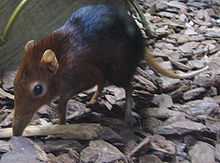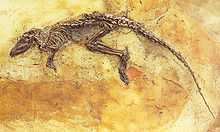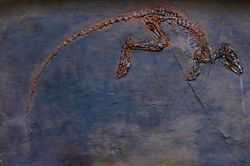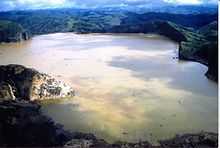Leptictidium
Leptictidium ("graceful weasel" in Latin) is an extinct genus of small mammals; together with macropods, ground pangolins, and humans, they are the only known completely bipedal mammals. Comprising five species, they resembled today's elephant shrews. They are especially interesting for their combination of characteristics typical of primitive eutherians with highly specialized adaptations, such as powerful hind legs and a long tail which aided in locomotion. They were omnivorous, their diet a combination of insects, lizards and small mammals. One of the first branches to split from basal eutherians,[1] they appeared in the Lower Eocene, a time of warm temperatures and high humidity, roughly fifty million years ago. Although they were widespread throughout Europe, they became extinct around thirty-five million years ago with no descendants,[2] probably because they were adapted to live in forest ecosystems and were unable to adapt to the open plains of the Oligocene. Description Leptictidium probably resembled today's elephant shrews. Leptictidium is a special animal because of the way its anatomy combines quite primitive elements with elements which prove a high degree of specialization. It had small fore legs and large hind legs, especially at the distal side (that further from the body). The lateral phalanges of its forelegs (fingers I and V) were very short and weak, finger III was longer and fingers II and IV were roughly equal in size, and slightly shorter than finger III. The tips of the phalanges were elongated and tapered.[1] The ankles and the sacroiliac joint were quite loosely fixed, while the pelvis had a flexible joint with only one coccygeal vertebra. The anteorbital muscle fenestrae in their crania suggest they probably had a long and mobile snout, similar to that of elephant shrews. Leptictidium had wide diastemata in the antemolar row,[3] its upper molar teeth were more transverse than those of the North American leptictids and its fourth premolars were molariform.[4] Its C1 canines were incisiviform. Its dentition was quite small in comparison to the size of the mandible and the animal as a whole.[3] It varied between 60 and 90 cm (24–36 in) in length[5] (more than half of which belonged to the bald tail),[6] and 20 cm (8 in) in height. It weighed a couple of kilograms.[7] These sizes could vary from one specimen to another. LocomotionOne of the mysteries about Leptictidium is whether it moved by running or by jumping. Because there are very few completely bipedal mammals, it is difficult to find an appropriate living model to compare it with. If the kangaroo is used, it is probable that Leptictidium hopped along with its body tilted forward, using its tail as a counterweight.[7] On the other hand, elephant shrews combine both types of locomotion; they usually move on four legs, but they can run on two legs to flee from a predator.[6] Studies of the bone structure of Leptictidium have yielded contradicting information: its leg articulations appear too weak to have supported the shock of repeated jumps, but its long feet were obviously adapted for jumping rather than running. Kenneth D. Rose compared the species L. nasutum with the leptictid Leptictis dakotensis. L. dakotensis had a series of traits which show it was a running animal which sometimes moved by jumping. Despite the marked similarities between Leptictis and Leptictidium, there are certain differences in their skeletons which prevent the example of Leptictis from being used to determine with certainty the way Leptictidium moved: the most important being that, unlike Leptictis, the tibia and the fibula of Leptictidium were not fused together.[8] BehaviourPerfectly preserved fossils of three different species of Leptictidium have been found in the Messel pit in Germany. The marks on their fur have been preserved, as well as their stomach contents, which reveal Leptictidium were omnivores which fed on insects, lizards and small mammals.[9] The holotype of L. tobieni also had pieces of leaves and notable amounts of sand in its abdomen, but it cannot be determined with certainty if the animal swallowed it.[3] Since Leptictidium young were very vulnerable to attacks of predators, it is probable that they were born quite developed and that they became independent when they were still quite young. From the behavior of today's elephant shrew, the possibility can be suggested that Leptictidium young went out to hunt with their mother, and that they learned to distinguish prey by licking their mother's mouth when she had just caught an animal, in order to know the flavor of food.[10] HabitatLeptictidium lived in the European subtropical forests of the Eocene. From the beginning of this period, the temperature of the planet rose in one of the quickest (in geological terms) and most extreme episodes of global warming in the geological record, termed Paleocene–Eocene Thermal Maximum. It was an episode of quick and intense (of up to 7°C in high latitudes) warming which lasted less than 100,000 years.[11] The thermal maximum caused a great extinction which is used to distinguish the Eocene fauna from that of the Paleocene. The global climate of the Eocene was probably the most homogeneous of the Cenozoic; the temperature gradient from the equator to the poles was half that of today's, and the deep ocean currents were exceptionally warm. The polar regions were much warmer than today, maybe as warm as the Pacific Northwest nowadays. Temperate forests reached the poles themselves, while rainy tropical climates reached 45° N. The greatest difference was in temperate latitudes; nevertheless, the climate at the tropics was probably similar to today's.[12] In the Eocene, most of what today is Europe, the Mediterranean and south-west Asia was submerged under the Tethys Sea. These two continents were separated by the Turgai Strait (an epeiric sea).[13] Due to high humidity and temperatures, most of the European continent was covered in vegetation. The region which today is Germany was in a volcanically active zone during the Eocene. It is thought that the Messel pit could have been the old location of a volcanic lake saturated with CO2. The lake would periodically release the gas it contained, creating a lethal cloud which would asphyxiate any animal in its path. This would explain the great number of non-aquatic species which have been found in the old lake-bed of the Messel pit.[citation needed] In the lush forests of this region, Leptictidium shared its habitat with animals such as Godinotia, Pholidocercus, Palaeotis or Propalaeotherium. There were also predators: Asiatosuchus, Lesmesodon, or the Messel giant ant. The alpha predator was Gastornis, a carnivorous bird almost two meters tall.[citation needed] SpeciesThe genus Leptictidium includes five species: Leptictidium auderienseDescribed by Heinz Tobien in 1962 based on a series of lower jaws from the Lutetian faunal stage. Tobien also uncovered a small skeleton he defined as a paratype of the species, but Storch and Lister proved in 1985 that, in fact, the skeleton did not even belong to the genus Leptictidium.[3] It was the smallest species of all and was only sixty centimetres long. Several skeletons have been found at the Messel pit.[14] Mathis remarks the exceptional development of the paraconid (or mesiobucal cusp) of the lower P4 premolar.[15] Its premolars and molars were quite small in comparison to the dentition as a whole. The name of the species refers to the Roman settlement of Auderia. Leptictidium ginsburgiDescribed by Christian Mathis in 1989. Fossils have been found in the lagerstätte at Robiac, Le Bretou, Lavergne, La Bouffie, Les Clapiès, Malpérié and Perrière (France), in Upper Ludian strata. The mesostyle typical of the Leptictidium genus is not developed in this species.[15] The species is dedicated to Léonard Ginsburg, French paleontologist and deputy director of the Muséum national d'histoire naturelle in París. Leptictidium nasutum Leptictidium nasutum Described by Adrian Lister and Gerhard Storch in 1985. It was a middle-sized species which was seventy-five centimeters long. Several skeletons have been found in the Messel pit,[14] in Lower Lutetian strata. The tail of this species had 42-43 vertebrae,[1] a number surpassed among mammals solely by the Long-tailed Pangolin. Its premolar and molar teeth were quite small in comparison to the dentition as a whole. The name of the species refers to the nose of the animal. The holotype is the complete skeleton of an adult specimen kept in the Forschungsinstitut Senckenberg in Frankfurt am Main.[1] Leptictidium sigeiDescribed by Christian Mathis in 1989. Fossils have been found in the lagerstätte at Sainte-Néboule, Baby, Sindou and Pécarel (France), and it has a more primitive appearance than L. nasutum. It is known mainly from isolated teeth. It has a P4 with a much reduced paraconid, as well as very distinct entoconids and hypoconulids on M1 and M2.[15] The species is dedicated to Bernard Sigé, French paleontologist. Leptictidium tobieni Fossil of Leptictidium tobieni at the Hessisches Landesmuseum, Darmstadt. Described by Wighart von Koenigswald and Gerhard Storch in 1987. It was the largest species of all at ninety centimetres long. It is one of the species found in the Messel pit,[14] in Lutetian strata. The species is dedicated to Heinz Tobien, descriptor of the genus Leptictidium and promotor of research in the Messel pit during the 1960s. The holotype is a complete and perfectly preserved skeleton of an adult specimen which was uncovered in September 1984 and which can be found at the Hessisches Landesmuseum Darmstadt.[3] There is also a paratype; a non-complete and badly preserved specimen which can be found at the Institut Royal des Sciences Naturelles de Belgique. It has a relatively robust mandible with a relatively large mesostyle. The molariform premolar teeth are a characteristic of the Leptictidium genus as a whole which is very marked in the P4 premolars of L. tobieni. The well-developed mesostyle and the transversal configuration of the upper molars are other typical traits of this species.[3] Comparison of the Messel speciesBy observing the clear morphological differences in the dentition of the three species found in Messel, the possibility can be discarded that either the discovered fossils are specimens of the same species but of different age, or that two of these forms belonged to the same species with a marked sexual dimorphism.[3] The Messel species developed very quickly a series of characteristic evolutionary traits, common to all of them, which separate them from the lagerstätte of Quercy.[15] This table compares the size of different specimens of each species found in the Messel pit (sizes in millimetres).
† From the front edge of the orbit. Evolutionary tendenciesIn his work Quelques insectivores primitifs nouveaux de l'Eocène supérieur du sud de la France (1989), French paleontologist Christian Mathis studied the evolutionary tendencies of the genus Leptictidium, based on comparison of the most primitive and the most recent species. From his observations, Mathis remarks:[15]
Related speciesTogether with the genus Pseudorhyncocyon, the five Leptictidium species form the family Pseudorhyncocyonidae, one of the three which form the order Leptictida. These families and genera are:[16] Order Leptictida
Because Leptictida is a paraphyletic group,[citation needed] this list does not take into account the families or genera with an uncertain or disputed affiliation. MediaA species of Leptictidium appears in episode 1 of BBC's Walking with Beasts, where a family of these animals survive a quake that releases carbon dioxide from a lake into the forest, in contrast with other animals which die suffocated. BibliographyIn English
In French
In German
References
External links | ||||||||||||||||||||||||||||||||||||||||||||||||||||||||||||||||||||||||||||||||||||||||||||||||||||||||||||||||||||||||||||||||||||||||||||||||||||||||||||||||||

